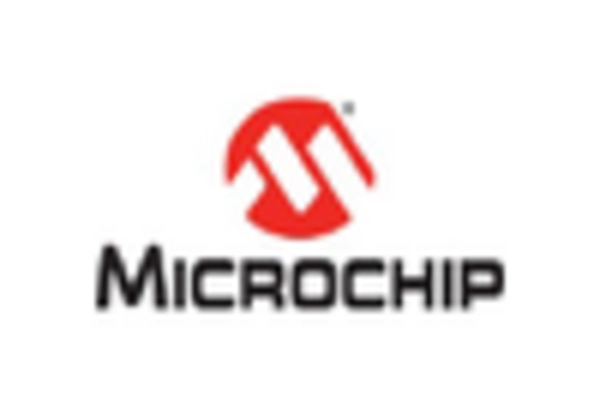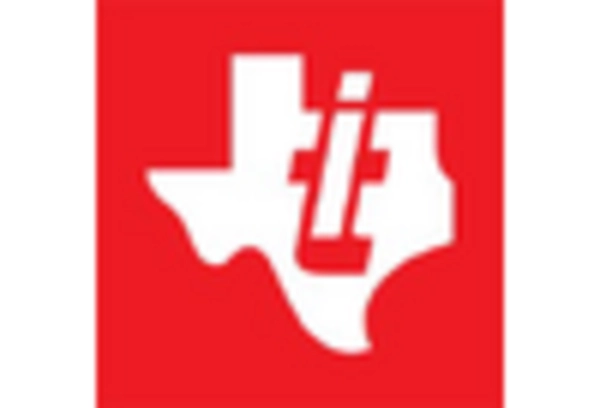Expansion of Wearable Technology
The wearable technology sector is experiencing rapid growth in Canada. This growth is significantly impacting the ultra low-power microcontroller market. With an increasing number of consumers adopting fitness trackers, smartwatches, and health monitoring devices, the demand for ultra low-power microcontrollers is likely to rise. According to industry estimates, the wearable technology market in Canada is expected to reach $3 billion by 2025, indicating a substantial opportunity for microcontroller manufacturers. These devices require microcontrollers that can operate efficiently for extended periods, often powered by small batteries. As a result, manufacturers are focusing on developing ultra low-power microcontrollers that can support advanced features such as real-time health monitoring and connectivity without compromising battery life. This trend suggests a promising future for the ultra low-power-microcontroller market as it aligns with consumer preferences for convenience and functionality.
Growing Adoption of Smart Devices
the increasing integration of ultra low-power microcontrollers in smart devices is a notable driver in the ultra low-power microcontroller market. As consumers in Canada increasingly embrace smart home technologies, the demand for energy-efficient solutions rises. Reports indicate that the smart home market in Canada is projected to reach approximately $10 billion by 2026, suggesting a robust growth trajectory. This trend necessitates the use of ultra low-power microcontrollers, which enable devices to operate efficiently while maintaining connectivity. Consequently, manufacturers are focusing on developing microcontrollers that not only consume minimal power but also support advanced functionalities, thereby enhancing user experience. The synergy between smart devices and ultra low-power microcontrollers is likely to propel market growth, as consumers seek sustainable and cost-effective solutions.
Increased Focus on Sustainability
Sustainability has emerged as a critical concern in Canada, influencing various sectors, including the ultra low-power-microcontroller market. As organizations strive to reduce their carbon footprint, the demand for energy-efficient microcontrollers is expected to surge. The Canadian government has set ambitious targets to reduce greenhouse gas emissions by 40-45% below 2005 levels by 2030, which may drive industries to adopt ultra low-power solutions. This regulatory environment encourages manufacturers to innovate and produce microcontrollers that align with sustainability goals. Furthermore, the emphasis on eco-friendly technologies is likely to attract investments in research and development, fostering advancements in ultra low-power microcontroller designs. As a result, the market may witness a shift towards products that not only meet performance standards but also contribute to environmental conservation.
Rising Investment in Smart Infrastructure
Investment in smart infrastructure is gaining momentum in Canada, serving as a significant driver for the ultra low-power-microcontroller market. As cities aim to enhance urban living through smart technologies, the demand for energy-efficient microcontrollers is expected to rise. Government initiatives aimed at modernizing infrastructure, such as smart traffic management systems and energy-efficient buildings, are likely to create opportunities for ultra low-power microcontroller applications. Reports suggest that the Canadian government plans to invest over $180 billion in infrastructure projects over the next decade, which may include smart technology integration. This investment could stimulate the development of ultra low-power microcontrollers that support various applications, from environmental monitoring to automated systems. Consequently, the ultra low-power-microcontroller market may experience substantial growth as it aligns with the broader trend of smart city development.
Advancements in Wireless Communication Technologies
The evolution of wireless communication technologies is a pivotal driver for the ultra low-power-microcontroller market. In Canada, the rollout of 5G networks is anticipated to enhance connectivity for various applications, including IoT devices and smart cities. This advancement necessitates the development of ultra low-power microcontrollers that can efficiently manage data transmission while minimizing energy consumption. As 5G technology becomes more prevalent, the demand for microcontrollers capable of supporting high-speed communication is likely to increase. Furthermore, the integration of ultra low-power microcontrollers in wireless sensor networks can facilitate real-time data collection and analysis, thereby improving operational efficiency across sectors. The synergy between wireless communication advancements and ultra low-power microcontrollers may lead to innovative applications, further driving market growth.
















Leave a Comment